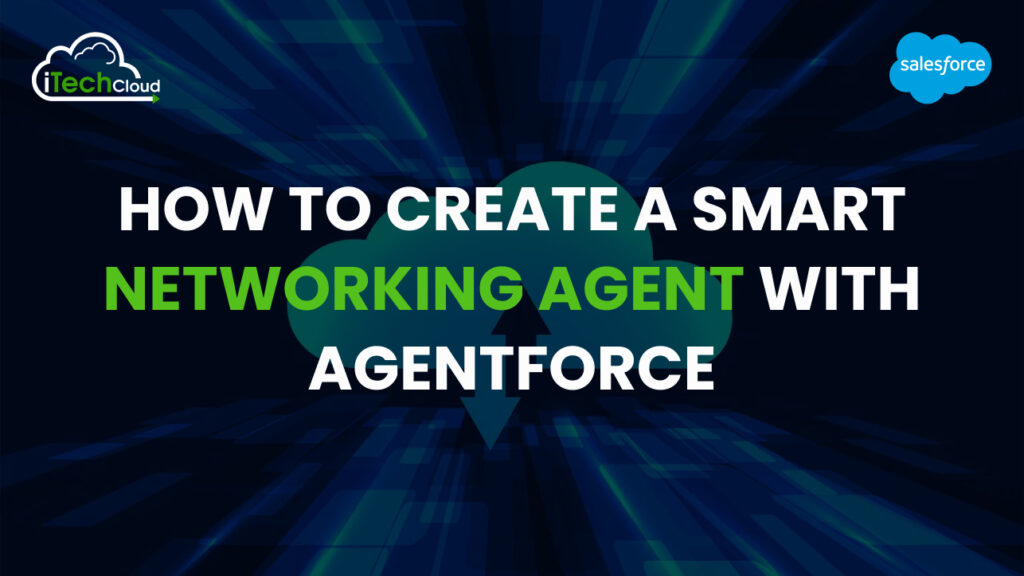How to Create a Smart Networking Agent with Agentforce

Introduction
In today’s fast-paced digital world, networking is a crucial skill for professionals, entrepreneurs, and businesses. However, manually managing connections, following up, and nurturing relationships can be time-consuming. This is where smart networking agents come into play.
Agentforce is a powerful platform that enables users to create AI-driven agents capable of automating networking tasks, engaging with contacts, and optimizing professional relationships. In this comprehensive guide.
Table of Contents
1. Understanding Smart Networking Agents
A smart networking agent is an AI-powered assistant designed to automate and optimize networking tasks. These agents can:
- Automate connection requests (e.g., LinkedIn, email outreach)
- Engage with contacts (e.g., sending follow-ups, responding to messages).
- Analyze networking opportunities (e.g., identifying key influencers).
- Schedule meetings and reminders.
- Personalize interactions based on user preferences.
Unlike traditional networking tools, AI-driven agents learn from interactions, adapt strategies, and improve over time.
2. Why Use Agentforce for Networking Automation?
Agentforce is a cutting-edge platform that allows users to create, train, and deploy AI agents for various tasks, including networking. Key benefits include:
✅ No-Code/Low-Code Development – Easily build agents without deep programming knowledge.
✅ AI-Powered Personalization – Use natural language processing (NLP) to craft human-like messages.
✅ Multi-Platform Integration – Connect with LinkedIn, email, CRM systems, and more.
✅ Automated Follow-Ups – Never miss an opportunity to nurture relationships.
✅ Analytics & Insights – Track engagement rates and optimize networking strategies.
With Agentforce, you can create a fully autonomous networking assistant that works 24/7 to expand your professional reach.
3. Step-by-Step Guide to Building a Networking Agent
Step 1: Define Your Networking Goals
Before building your agent, clarify what you want to achieve:
- Lead generation?
- Partnership development?
- Job opportunities?
- Industry insights?
Your agent’s behavior will depend on these objectives.
Step 2: Set Up Your Agentforce Account
- Sign up on Agentforce’s platform.
- Choose a networking agent template or start from scratch.
Step 3: Configure Your Agent’s Core Functions
- Connection Requests: Set rules for sending invites (e.g., only to people in tech startups).
- Automated Messaging: Craft personalized intro messages and follow-ups.
- Response Handling: Train the agent to reply to common queries.
Example automation flow:
- Trigger: New LinkedIn connection accepted.
- Action: Send a thank-you message + a relevant resource.
- Follow-Up: Check in after 7 days if no response.
Step 4: Integrate with Networking Platforms
Agentforce supports integrations with:
- LinkedIn (via API or browser automation)
- Email (Gmail, Outlook)
- CRM (HubSpot, Salesforce)
- Calendly (for scheduling meetings)
Step 5: Train Your AI with Custom Data
- Upload past networking emails for tone analysis.
- Provide examples of successful conversations.
- Adjust response styles (formal, casual, persuasive).
Step 6: Test & Deploy
- Run simulations to see how the agent interacts.
- Monitor initial responses and refine messaging.
- Deploy in “assisted mode” (human oversight) before full automation.
4. Key Features to Enhance Your Networking Agent
To maximize efficiency, equip your agent with these advanced features:
A. AI-Powered Personalization
- Use dynamic placeholders (e.g., “Hi [First Name], I noticed your work on [Recent Post Topic]…”)
- Analyze profiles to tailor messages (e.g., mention shared connections).
B. Smart Follow-Up Sequences
- 1st follow-up: 3 days after connection.
- 2nd follow-up: 7 days later with added value (e.g., article, event invite).
- Final follow-up: Polite exit if no response.
C. Lead Scoring & Prioritization
- Rank contacts based on engagement level.
- Focus efforts on high-potential leads.
D. Meeting Scheduling Automation
- Sync with Calendly or Google Calendar.
- Auto-send meeting invites after confirmation.
E. Sentiment Analysis
- Detect if a contact is interested/unresponsive.
- Adjust follow-up strategy accordingly.
5. Best Practices for Effective Networking Automation
While AI can streamline networking, human touch remains essential. Follow these best practices:
✔ Avoid Spammy Behavior – Don’t send generic messages.
✔ Balance Automation & Personalization – Review automated messages periodically.
✔ Respect Response Times – Don’t overwhelm contacts with rapid follow-ups.
✔ Monitor & Optimize – Track open/reply rates and refine strategies.
6. Future Trends in AI-Powered Networking
AI-driven networking will continue evolving with:
🔹 Voice & Chatbot Assistants (e.g., AI making phone calls).
🔹 Predictive Networking (AI suggesting who to connect with before you even know them).
🔹 Blockchain-Based Verification (ensuring authentic professional identities).
Conclusion: Networking Agent with Agentforce
Creating a smart networking agent with Agentforce can revolutionize how you build and maintain professional relationships. By automating repetitive tasks, personalizing interactions, and leveraging AI insights, you can focus on high-value networking while your agent handles the rest.

